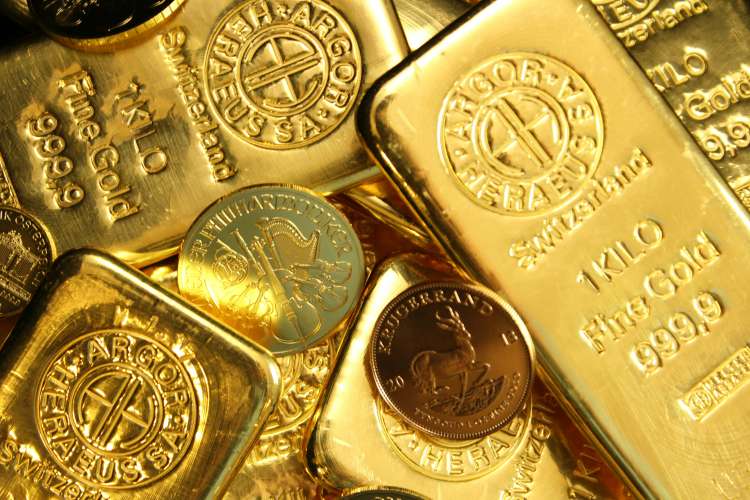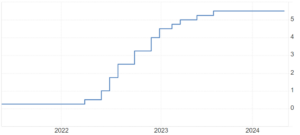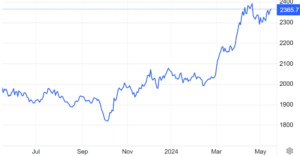
In recent months, gold prices have experienced a steady ascent, reaching new all-time highs in May 2024. The precious metal, trusted as a safe haven during times of economic uncertainty, has been asubject of intense market speculation and strategic investment. This surge is driven by a confluence of economic factors, geopolitical tensions, and shifts in global investment patterns, with significant contributions from both Western and Eastern markets.
Bullion is luring investors with its resilience in the face of a strengthening dollar and rising interest rates. One of the reasons behind the current rally is growing expectations of a dovish pivot by the US Federal Reserve. A recent Reuters poll showed that a majority of economists expect the Fed to lower its benchmark rate at least twice this year starting in September. This prospect has buoyed yellow metal prices, as lower interest rates decrease the opportunity cost of holding gold.
READ | Food inflation: Rains may save India from price spiral
Economic indicators and Fed rates
A primary driver of the current gold price surge is the anticipation of interest rate cuts by US Federal Reserve. Reports indicate that traders are closely monitoring key inflation data, with expectations that a softer Consumer Price Index could prompt the Fed to reduce rates. Gold, which does not yield interest, typically benefits from lower real interest rates—borrowing costs adjusted for inflation. As core inflation is expected to show a modest increase of 0.3% month-over-month in April, down from 0.4% the previous month, the annual rate is predicted to fall to 3.6%. Such conditions are likely to support a bullish short-term momentum for bullion, potentially propelling it towards its all-time high levels.
United States Fed Funds Rate (%)

Additionally, weaker job reports and softer-than-expected U.S. payroll data for April have increased the likelihood of rate cuts this year. According to a Reuters poll, a stronger majority of economists expect the Fed to reduce its key interest rate twice this year, starting in September. This expectation has buoyed yellow metal prices, as lower interest rates reduce the opportunity cost of holding non-yielding assets like gold.
Gold Prices at Record High ($ per ounce)

Geopolitical uncertainty and inflation concerns
Conflicts such as Russia’s invasion of Ukraine and escalating tensions in the Middle East, including Israeli strikes on Iranian targets, have heightened the yellow metal’s appeal as a safe-haven asset.
Gold’s rally has been further propelled by speculative activity in futures markets, particularly from investors looking to capitalise on the upward momentum. Call options have been heavily traded, with speculators betting on continued price increases driven by robust demand from both central banks and retail investors. This speculative behaviour has amplified bullion’s price movements, contributing to its recent highs. In addition, rising oil prices, with Brent crude nearing $90 a barrel, have stoked fears of a rebound in inflation. This inflationary pressure makes gold, a traditional hedge against inflation, an attractive investment.
Statements from Federal Reserve officials indicating that multiple rate cuts might be warranted this year, despite a strong economy, have added to the bullish outlook. As inflation remains above target, the Fed’s dovish stance on rates has raised concerns about larger declines in real rates should inflation rise unexpectedly.
Remarkably, the yellow metal has continued its ascent despite traditionally adverse conditions such as a strong US dollar and high interest rates. Typically, a strong dollar makes gold more expensive for holders of other currencies, and higher interest rates increase the opportunity cost of holding non-yielding assets like gold. However, sustained demand from Chinese investors and central bank purchases have mitigated these effects, showcasing the metal’s resilience.
China’s role in gold markets
China’s influence on the bullion market has become increasingly pronounced. Chinese consumers, facing a sluggish real estate market and lacklustre stock performance, have turned to gold as a reliable investment. On the retail front, the enthusiasm for gold has been notable among younger Chinese consumers who are turning to innovative products like gold beans. These small, affordable pieces of gold have become popular as both an investment and a collectible, driven by aggressive online marketing and a cultural shift towards alternative investments. This trend highlights a broader movement among retail investors towards tangible assets amidst economic uncertainty.
The surge in Chinese gold demand is not just retail-driven but also involves substantial central bank purchases. The People’s Bank of China has been steadily increasing its gold reserves, aiming to diversify its holdings and reduce dependence on the US dollar.
In 2023 alone, the Chinese central bank added more gold to its reserves than any other central bank, continuing this trend into 2024. The shift from US Treasury holdings to gold is partly a response to the geopolitical risk posed by potential sanctions, similar to those imposed on Russia. This strategic accumulation of gold is a significant factor in the metal’s price dynamics, with China’s central bank now holding gold equivalent to 4.6% of its foreign exchange reserves.
The strategic purchases by central banks, particularly in China, have not only driven up gold prices but also influenced global market dynamics. The steady accumulation of gold reserves by central banks has provided a stable demand floor for the metal, cushioning it against price volatility. This trend reflects a growing preference for gold as a diversification tool in reserve management, emphasising its role in the global financial system.
India has also played a critical role in the global gold market. The Reserve Bank of India has significantly increased its yellow metal reserves, with a 40% surge in domestic holdings between March 2019 and March 2024. This rise reflects a broader strategy to bolster foreign exchange reserves and ensure reserve adequacy. As of March 2024, India’s gold reserves stood at 822 metric tonnes, with an increased share of the precious metal in the country’s foreign exchange reserves.
The surge in bullion prices is a complex phenomenon influenced by monetary policies, geopolitical tensions, and strategic reserve management by central banks. The interplay of these factors has created a robust environment for the metal, propelling it to new heights. As global economic conditions remain uncertain, the allure of the precious metal as a stable investment is likely to persist, driven by both Western economic policies and Eastern consumer behaviour.
Gold remains a barometer of economic sentiment, reflecting the collective anxieties and strategic decisions of investors worldwide. The current trajectory of bullion prices is a proof of its enduring status as a refuge in times of turmoil and a strategic asset in an uncertain global economy.

